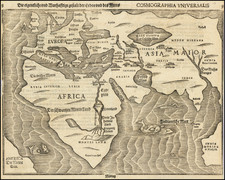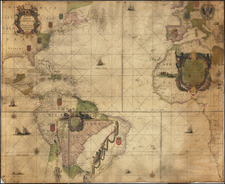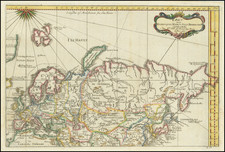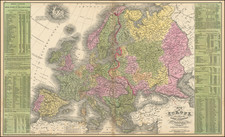Rare separately published George Willdey map of Europe,
Includes a decorative allegorical cartouche, vignette of 3 costumed figures learning to use navigational devices and mileage scale, along with a larger inset advertisement for George Willdey's "Great Toy Shop next [to] the Dogg Tavern in Ludgatestreet," and in illustrated assortment of practical, scientific and other objects sold by Willdey.
The map also includes and table of other maps published by Willdey.
Rarity
All Willdey maps are are on the market.
AMPR notes 1 example in a dealer catalog in the past 40 years (Martayan Lan, 1993). RBH notes 2 examples at auction in the past 40 years.
George Willdey was an optical instrument maker. He also sold globes, maps, and toys at his shop in Ludgate Street. Born in Staffordshire, Willdey moved to London after the death of his father, where he was bound as an apprentice to John Yarwell, an optician. He was made free of the Spectaclemakers’ Company in 1702, when he began work as a journeyman.
A few years later, Willdey started in business with Timothy Brandreth, working under the sign of the Archimedes and Globe. They competed for business with Yarwell and other opticians, advertising their wares in trade cards and periodical advertisements.
Willdey and his wife, Judith, had five children, three of which survived to adulthood. Judith was a Huguenot, which allowed Willdey to create a wider network of artisans and craftsman. He expanded his stock to toys and household decorations, in addition to instruments. From 1709 he also sold printed goods, including maps and globes, which he sold in partnership with John Senex. Willdey purchased the copper plates for many maps, such as Christopher Saxton’s atlas of England and Wales.
We note the following addresses:
- From 1707 to 1713 he operated "At the Archemedes & Globe, Ludgate Street." sometimes described as "Archimedes and Globe next the Dog Tavern nearer Ludgate."
- In 1712 in partnership with Timothy Brandreth also advertised at Archimedes and Globe over against the Royal Exchange in Cornhill.
- In 1715 his location was described as "At the Great Toy and Print Shop, the corner of Ludgate Street, next to St. Paul's"
- 1718 to 1737 as "At the Great Toy, Spectacle, China-Ware, and Print Shop, the Corner of Ludgate Street near St. Pauls London."
In 1717, Willdey split with Brandreth and expanded his stock further to include coffee and tea, snuff, medicine, china, and cutlery. He sold these wares from his shop at Ludgate and St. Paul’s Churchyard. He aggressively advertised his business in hundreds of newspaper advertisements; he also adopted many advertising gimmicks, such as erecting a giant burning glass on the roof of his store. Willdey was a leader in the Spectaclemakers’ Company. His wife frequently helped with the business and eight of his fifteen apprentices were women, which was very unusual for either the instrument and toy trades at the time.
Willdey died in 1737, although he had been in declining health for years and had tried to pass the business to his son, Thomas. He was remembered in The Old Whig, or, the Consistent Protestant as the “most noted Toyman in Europe.” After his death, the shop was run by Judith along with a former apprentice, Susanna Passavant. Thomas, it seems, was not suited to business.
Willdey’s daughter, Jane Frances, married a Peter Fenoulhet, clerk of the entries in the Excise Office. Fenoulhet sued on behalf of their son over the mismanagement of the family business by Thomas. These lawsuits produced eleven inventories of household and commercial stock between 1730 and 1737, the only extant shop accounts from the London instrument trade from this period.









![[Europe: Air Mail Routes] Carte des lignes postales aeriennes internes et internationales Europe pubilee par le Bureau International de l'Union postale universelle Berne, Avril 1937](https://storage.googleapis.com/raremaps/img/small/41144.jpg)

![(Hannibal Crosses the Alps) Expeditiones Hannibalis per Hispaniam, Galliam, Italiam, Africam &c. ex Plutarcho &c. . . . [The expeditions of Hannibal through Spain, Gaul, Italy, Africa, &c. from Plutarch &c. . . .]](https://storage.googleapis.com/raremaps/img/small/85241.jpg)


